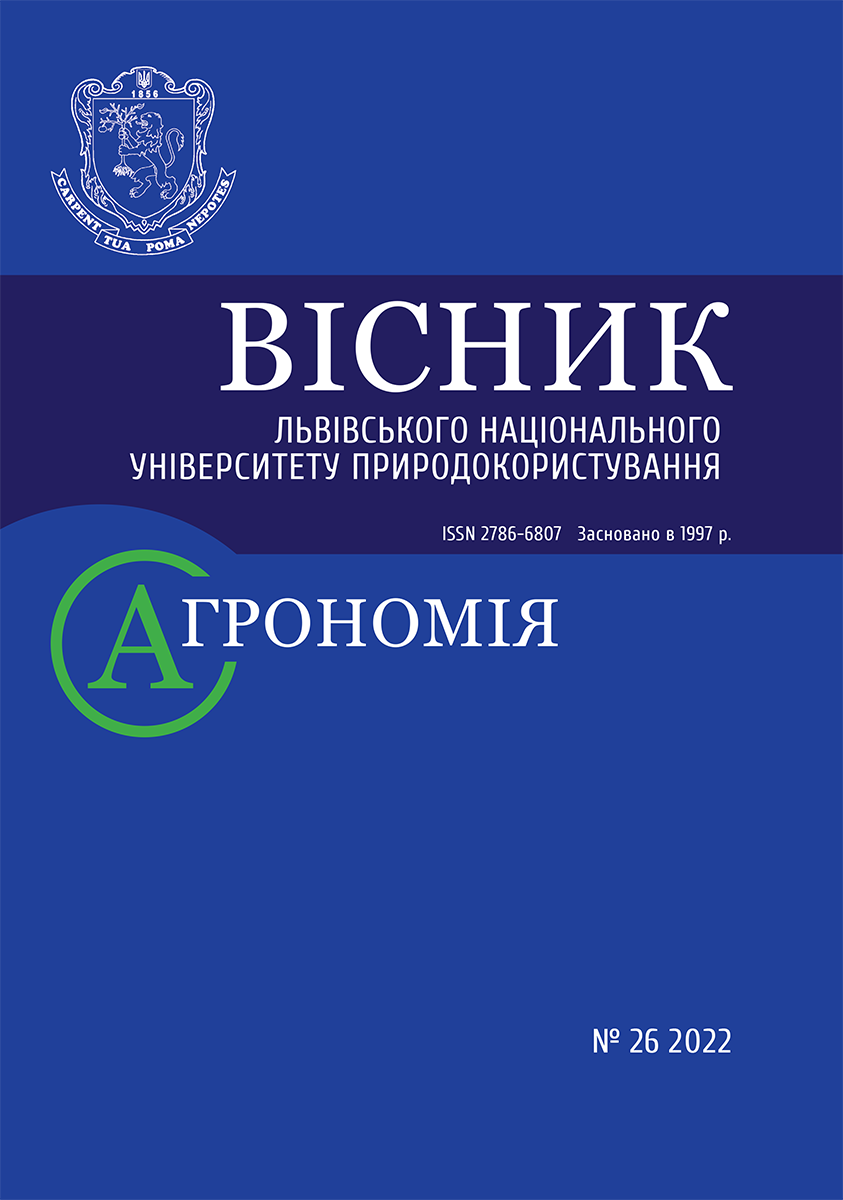INFLUENCE OF ANTHROPOGENIC FACTORS ON RIVERS OF THE WESTERN REGION OF THE UKRAINIAN CARPATHIANS
DOI:
https://doi.org/10.31734/agronomy2022.26.022Keywords:
urbanized areas, anthropogenic impact, water quality indicators, mountain streams, small hydropower plantsAbstract
Anthropogenic burden on water bodies is constantly increasing due to population growth and urbanization processes characterizing our time. A significant human impact on water bodies is an objective circumstance, because today, technology is the basis of the world economy and uses a lot of water, and discharges after production are very polluted. Heavy pollution of aquatic ecosystems with nutrients and runoff of agricultural land has led to the eutrophication of not only lakes and reservoirs, but also many watercourses. Significant factors of anthropogenic eutrophication of water bodies include reduction of water exchange, formation of stagnant zones, construction of dams and thermal pollution of water. The aim of the work is to assess the impact of urbanization of the Western region of the Ukrainian Carpathians on the ecological condition of rivers and natural self-cleaning processes.
Assessment of the impact of urbanization of the Western region of the Ukrainian Carpathians on the ecological status of rivers showed unsatisfactory hydrochemical parameters of some small rivers in the region. The study confirms an excess of the standard values of the indicators of total iron (2.4 times) manganese (5 times) and suspended solids – 1.53 times for fishery waters. Anthropogenic activities related with agricultural production, water and forestry activities, plowing and deforestation lead to a significant change in the conditions of river runoff formation. In particular, the main volumes of river water pollution are caused by insufficient treatment of sewage at treatment facilities, rainwater from the territory of industrial areas that are not treated, wash away from water catchments of fertilizers and pesticides introduced into the soil, unauthorized dumps of household waste in riverbeds, and unauthorized mining developments that worsen the hydrological regime and the processes of natural water purification.
References
Anthropogenic changes in biogeocenotic cover in the Carpathian region / ed. M. A. Golubets. Kyiv: Scientific Opinion, 1994. 166 p.
Issues and challenges of small hydropower development in the Carpathians region (hydrology, hydro-chemistry, and hydrobiology of watercourses) / Kovalchuk A., Obodovskiy O., Shcherbak V. et al. Uzhgorod; Lviv; Kyiv: Hydroecological Society «Uzh», 2016. 195 p.
Ivanov E. Estimation of the state of regional geocomplexes in the conditions of influence of the mining industry (on the example of Lviv region). Bulletin of Lviv. Un-ty. Ser. geographer. 2003. Vol. 29. Part 2. P. 176–183.
Ivanov E. A., Bilaniuk V. I., Tykhanovych E. E. Assessment of the ecological condition of geosystems of mining areas. Subsoil Use in Ukraine. Investment Prospects: Fifth Internat. Scient. and Pract. Conf. (Ukraine, Truskavets, October 8–12, 2018). Truskavets, 2018. P. 75–81.
Karpenko N. P., Hlazunova I. V. Management of land and water resources to reduce river pollution based on expert assessments of the effectiveness of environmental protection measures. Environmental engineering. 2019. No 4. P. 102–108.
Melnyk A. V. Ukrainian Carpathians: ecological and landscape research. Lviv, 1999. 286 p.
Mykitchak T. I. Influence of functioning of Tereble-Ritska HPP on grouping of invertebrate aquatic organisms of the rivers Rika and Tereblya (Ukrainian Carpathians). Scientific bases of biotic diversity conservation. 2015. Vol. 6 (13), No 1. P. 249–262.
Mykitchak T., Shtupun V. Influence of Yavir HPP functioning on the group of invertebrates of the Stryi River (Ukrainian Carpathians). Bulletin of Lviv University. Biological series. 2017. Issue 76. P. 77–86.
Nesterova O. V., Sharkov V. V., Zhuravliova O. A., Nesterov Ya. S. Problems of small river basins. Bulletin of the Dnieper State Academy of Civil Engineering and Architecture. 2019. No 5. P. 257–258.
Pankiv N. M. Historical and geographical features of the formation of the settlement network of the Ukrainian Carpathians. Visnyk of Lviv. Un-ty. Geography series. 2009. No 36. P. 255–260.
Rudko H. I. Estimation of technogenic changes of geological environment and questions of the controlled control of technogenesis (on an example of the Carpathian region of Ukraine). Geoecol. Eng. geol. Hydrogeol. Geocryol. 1999. No 1. P. 15–25.
Selezneva A. V. Anthropogenic load on rivers from point sources of pollution. Proceedings of the Samara Scientific Center of the RAS. 2003. Vol. 5. No 2. P. 268–277.
Snitynskyi V. V., Hnativ P. S., Lopotych N. Ya. Ecosafety and protection of the natural environment of the Eastern Beskyds: monograph. Lviv: Kamula, 2018. 180 p.
Snitynskyi V. V., Khirivskyi P. R., Hnativ I. R. Features of surface runoff formation of mountain rivers during deforestation and plowing of slope areas. Scientific and practical journal «Environmental Sciences». 2020, No 3 (30). P. 73–77.
Snitynskyi V. V., Khirivskyi P. R., Hnativ I. R. Processes of self-purification for the influence of urbanization of territories on the foothills and plain areas of the river Stryi. Bulletin of LNAU: agronomy. 2021. No 25. P. 30–34.
Spitsyna T. P., Taseiko O. V. Complex criteria for self-cleaning of watercourses. Bulletin of TVGU. Series «Biology and Ecology». 2018. No 2. P. 248–262.
Sukhareva O. Yu., Riabukhina T. S., Delehan-Kokaiko S. V, Sukharev S. M. Influence of a small HPP on the state of the Shypot River. Nauk. Bulletin of Uzhhorod. Un-ty. Ser. chem. 2015. No 2 (34). P. 51–54.
Vovkunovych M. I., Roman L. Yu., Chundak S. Yu. Anthropogenic activity on the territory of Skole Beskyds National Park and its impact on the ecological condition of the hydro network. Science. Bulletin of Uzhhorod. University (Ser. Chemistry). 2020, No 1 (43). P. 86–91.


